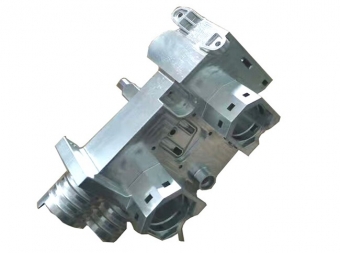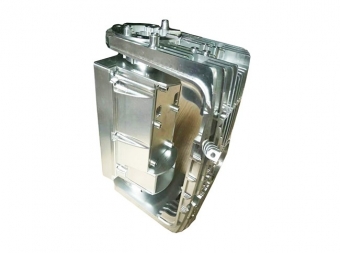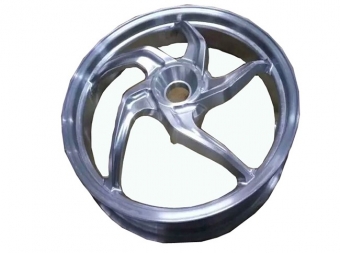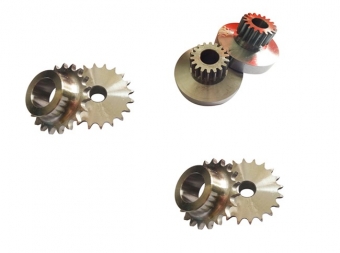


cnc milling metal parts The machining process begins by using CAD software to create a 3D model of the desired part. The model is then imported into CAM software, which generates tool paths and instructions for the CNC machine tool. Once the design and specifications are finalized, the metal pieces are mounted on the CNC machine and the cutting tools begin running.
The main advantage of cnc milling metal parts technology is the ability to produce parts with high precision, consistency and tight tolerances. This is achieved through the use of advanced software that controls the movement of CNC machine tools, allowing complex cuts and shapes to be achieved with precision. In addition to precision, cnc milling metal parts machines offer high levels of efficiency. By using computer programming, these machines can work continuously and quickly, reducing production time and costs. The versatility of cnc milling metal parts technology allows for the machining of a variety of materials, including steel, aluminum, Titanium, brass and titanium. This makes it a valuable tool in industries such as aerospace, automotive and medical that often use different types of metals. Some key parameters to consider when using cnc milling metal parts technology include the type of CNC machine being used, spindle speed, feed rate and depth of cut. These parameters can be adjusted and optimized to achieve the desired results, making it a highly customizable process.
| Material: |
Aluminum (6061-T6, 6063, 7075-T6,5052) etc... Brass/Copper/Bronze etc... Stainless Steel (302, 303, 304, 316, 420) etc... Steel (mild steel, Q235, 20#, 45#) etc... Plastic (ABS, Delrin, PP, PE, PC, Acrylic) etc... |
| Process: | CNC Machining, CNC turning, CNC milling, CNC lathe machining, CNC boring, CNC grinding, CNC drilling etc... |
| Surface treatment: |
Clear/color anodized; Hard anodized; Powder-coating; Sand-blasting; Painting; Nickel plating; Chrome plating; Zinc plating; Silver/gold plating; Black oxide coating, Polishing etc... |
|
Gerenal Tolerance: (+/-mm) |
CNC Machining: 0.005 Turning: 0.007 Grinding(Flatness/in2): 0.005 ID/OD Grinding: 0.002 Wire-Cutting: 0.002 |
| Certification: | ISO9001:2008, ROHS |
| Production capacity: | depend on complicacy of different products and the quantity |
| Experience: |
15 years of CNC machining products 3 years of automation machine manufacturing |
| Packaging : |
Standard: pearl cotton and bubble bag, carton box and seal For large and big quantity: pallet or as per customers' requirement |
| Lead time : | In general:8-11days |
| Term of Payment: | T/T, Paypal, Trade Assurance etc... |
| Minimum Order: | Comply with customer's demand |
| Delivery way: | Express(DHL,Fedex, UPS,TNT,EMS), By Sea, By air, or on your requirement |



cnc milling metal parts FAQs Guide. we will delve into the specifics of cnc milling metal parts machining and explore its advantages, applications, and key considerations for successful implementation. Whether you are new to the field or looking to expand your knowledge, this guide will provide a comprehensive overview of this revolutionary manufacturing process. So, let's begin our journey into the world of cnc milling metal parts machining!
1.Is it possible to add threading to a metal piece using CNC?
As one of the top cnc milling metal parts manufacturers in China, we take this very seriously. Yes, it is possible to add threading to a metal piece using CNC. This is done by using a threading tool, which is a specialized cutting tool designed to cut threads into a workpiece. The threading tool is mounted in the spindle of the CNC machine and is programmed to cut the desired thread profile into the workpiece.
2.How does the rigidity of the machine affect the outcome of cnc milling metal parts machining?
We continuously upgrade our skills and knowledge to adapt to changing cnc milling metal parts market needs. The rigidity of the machine affects the outcome of metal CNC machining in several ways. A rigid machine will be able to hold the cutting tool in a more precise position, resulting in more accurate cuts and better surface finish. A rigid machine will also be able to handle higher cutting forces, allowing for faster cutting speeds and deeper cuts. Finally, a rigid machine will be less prone to vibration, which can cause poor surface finish and inaccurate cuts.
3.How does the cost of cnc milling metal parts machining compare to traditional machining methods?
We operate our cnc milling metal parts business with integrity and honesty. The cost of metal CNC machining is typically higher than traditional machining methods due to the complexity of the process and the need for specialized equipment. CNC machining also requires more time and labor to complete a job, which can add to the cost. However, CNC machining can produce more precise and accurate parts than traditional machining methods, which can offset the higher cost.
4.Is it possible to perform reverse engineering using cnc milling metal parts machining?
Yes, it is possible to perform reverse engineering using metal CNC machining. This process involves taking a physical object and using a CNC machine to create a 3D model of the object. This model can then be used to create a new version of the object or to modify the existing object.

5.About cnc milling metal parts quality system
Metal CNC quality systems are designed to ensure that the parts and components produced by CNC machines meet the highest standards of quality and accuracy. Quality systems typically include a set of processes and procedures that are used to monitor and control the quality of the parts and components produced. These processes and procedures may include quality control checks, inspections, and testing. Quality systems also typically include a system of documentation and records that are used to track and monitor the quality of the parts and components produced. Quality systems are essential for ensuring that CNC parts and components meet the highest standards of quality and accuracy.
6.What is the role of proper tool selection in cnc milling metal parts machining?
Our mission is to provide customers with the best solutions for cnc milling metal parts. The proper selection of tools is essential for successful metal CNC machining. The right tool for the job will ensure that the machining process is efficient and accurate. The selection of the right tool will also help to reduce the risk of tool breakage and machine damage. The selection of the right tool will also help to reduce the cost of machining and improve the quality of the finished product.
7.How accurate is the precision of cnc milling metal parts machining?
We focus on teamwork and communication to achieve common goals, We attach great importance to this detail. The precision of metal CNC machining is typically very high, with tolerances of up to 0.001 inches (0.025 mm) achievable. However, the accuracy of the machining process depends on a variety of factors, including the quality of the machine, the skill of the operator, and the type of material being machined.
8.Can cnc milling metal parts machines be automated for continuous production?
Our company has many years of cnc milling metal parts experience and expertise. Yes, metal CNC machines can be automated for continuous production. Automation can be achieved by using a CNC controller, which is a computer-controlled device that can be programmed to control the machine's movements and operations. Automation can also be achieved by using a robotic arm, which can be programmed to perform specific tasks. Automation can help to increase production efficiency and reduce costs.

9.What is the role of the spindle speed in cnc milling metal parts machining?
We are a professional cnc milling metal parts company dedicated to providing high quality products and services. The spindle speed is an important factor in metal CNC machining. It determines the speed at which the cutting tool moves across the material, and affects the quality of the finished product. A higher spindle speed will result in a faster cutting process, but can also cause the cutting tool to wear out faster. A lower spindle speed will result in a slower cutting process, but will also reduce the wear on the cutting tool. The spindle speed must be carefully adjusted to ensure the best results.
10.What are the safety measures for handling sharp edges in a CNC machine?
We focus on our customers' needs and strive to meet their expectations, so we take this very seriously. 1. Wear protective clothing such as safety glasses, gloves, and long sleeves. 2. Ensure that the machine is properly guarded and that all safety devices are in place and functioning. 3. Keep hands away from the cutting area and use tools to adjust the cutting tool. 4. Use a push stick to move material away from the cutting area. 5. Use a vacuum to collect chips and dust. 6. Use a chip shield to protect the operator from flying chips. 7. Use a dust collection system to keep the air clean. 8. Keep the work area clean and free of debris. 9. Make sure the machine is properly lubricated and maintained. 10. Make sure the machine is properly grounded.
11.How does the machine's rigidity affect the speed and accuracy of cnc milling metal parts machining?
The rigidity of the machine affects the speed and accuracy of metal CNC machining in several ways. A more rigid machine will be able to handle higher cutting forces, allowing for faster cutting speeds and more accurate cuts. A more rigid machine will also be less prone to vibration, which can cause inaccuracies in the finished product. Additionally, a more rigid machine will be able to hold tighter tolerances, resulting in more precise parts.
12.About cnc milling metal parts raw materials
Metal CNC raw materials are typically metals such as aluminum, steel, brass, and copper. These materials are used to create parts and components for a variety of applications, including automotive, aerospace, and medical. The raw materials are cut and shaped using CNC machines, which are computer-controlled machines that use a variety of tools to cut and shape the material. The raw materials are then machined and finished to create the desired product.

13.About cnc milling metal parts origin
Metal CNC origin is a term used to describe the process of using computer numerical control (CNC) machines to create metal parts and components. CNC machines are automated machines that use computer-controlled instructions to cut, shape, and form metal into a desired shape or size. CNC machines are used in a variety of industries, including aerospace, automotive, medical, and industrial. CNC machines are used to create parts for a variety of applications, including medical implants, automotive components, and aerospace components.
14.What is the role of CAD software in cnc milling metal parts machining?
cnc milling metal parts is not a product only, but also can help you comes to money-making. CAD software is used to create 3D models of the parts that need to be machined. The CAD software is then used to generate the CNC code that will be used to control the CNC machine. The CNC code contains instructions for the machine to move the cutting tool around the part in order to create the desired shape. The CAD software also allows the user to simulate the machining process, which helps to ensure that the part will be machined correctly.
15.How does the speed of the machine affect the production process?
We adhere to the principle of quality first and have a complete production quality management system and quality inspection process. The speed of the machine affects the production process by determining how quickly the production process can be completed. Faster machines can produce more products in a shorter amount of time, while slower machines will take longer to produce the same amount of products. Faster machines also allow for more efficient use of resources, as they can produce more products with fewer resources. Additionally, faster machines can reduce the amount of time needed for setup and changeover, which can help to reduce costs and improve efficiency.
16.What are the common applications of cnc milling metal parts machining in the aerospace industry?
We have established a good reputation and reliable partnerships within the cnc milling metal parts industry. 1. Aircraft engine components: CNC machining is used to create components for aircraft engines, such as turbine blades, compressor blades, and other engine components. 2. Aircraft structural components: CNC machining is used to create components for aircraft structures, such as fuselage frames, wing spars, and other structural components. 3. Aircraft landing gear components: CNC machining is used to create components for aircraft landing gear, such as landing gear struts, wheels, and other components. 4. Aircraft interior components: CNC machining is used to create components for aircraft interiors, such as cabin walls, seats, and other interior components. 5. Aircraft instrumentation components: CNC machining is used to create components for aircraft instrumentation, such as navigation systems, autopilot systems, and other instrumentation components.

17.How does the rigidity of the workpiece affect the accuracy of cnc milling metal parts machining?
The rigidity of the workpiece affects the accuracy of metal CNC machining because it affects the stability of the cutting process. If the workpiece is not rigid enough, it can cause vibrations during the cutting process, which can lead to inaccuracies in the finished product. Additionally, if the workpiece is too rigid, it can cause excessive tool wear and reduce the accuracy of the machining process.
18.What is the role of CAM software in cnc milling metal parts machining?
Our products & services cover a wide range of areas and meet the needs of different fields. CAM software is used to create the instructions for the CNC machine to follow when machining metal. It is used to create the toolpaths that the machine will use to cut the metal, as well as to set the speeds and feeds for the cutting tools. It also helps to optimize the machining process by ensuring that the cutting tools are used in the most efficient way possible.